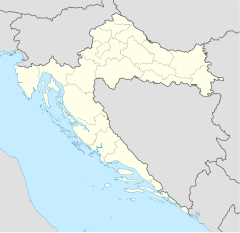Donji Lapac
Donji Lapac (Serbian: Доњи Лапац) is a small town and municipality in Lika-Senj county, Croatia. The majority of the population are Serbs.
Geography
Donji Lapac is located in east Lika (also called Ličko Pounje), by the river Una that flows near the town in the valley between mountain Plješevica and Una on the altitude of 582m. It is connected with the road that connects Bihać with Gračac.
Demographics
According to the 2001 census, the town has population of 812 and a municipality of 1,880 people. Before the war the area was almost entirely Serb populated with only 0.5% Croats (according to the 1991 census). After the war the area of Donji Lapac municipality grew smaller because villages of Donji Srb and Gornji Srb were given to Municipality of Gračac in Zadar county. However according to the 2001 census Serbs continue to constitute a majority of 73.6% and Croats 25.1%.
History
The area of Donji Lapac has been inhabitated since the Iron age, which many material remainings prove. During medieval times the area of Lapac was part of old-slavic Lapac župa and in 1449 it became possession of Frankopans. Old city Lapac was located on a nearby Obljaj hill (666m) south from Donji Lapac. When in 1528 Ottomans conquered Lika, Lapac was absorbed.
Donji Lapac was founded in 1791, in the year the Austro-Ottoman war ended and Eastern Lika was annexed by Habsburg empire as a frontier post. In 1941 Yugoslav partisans liberated the district center.
Economy
Today Donji Lapac is one of the poorest municipalities in Croatia and is included in area of special state care. Before the war, Donji Lapac had a developed wood and textile industry. Many people worked in the transportation company Likatrans which employed more than 200 people. Today most of the inhabitants are unemployed and jobs are mostly restricted to public services or the renewed wood industry. Additionally many people work in basic agriculture, growing mostly potatoes and plums from which they make the alcohol Slivovitz.


